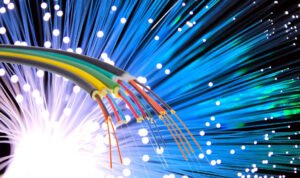Understanding the Basics of Fibre Optic Cables
 Fibre optic cables have become a cornerstone of modern communication technology. They are pivotal in transmitting data at high speeds across long distances with minimal loss. As we delve into the basics of fibre optic cables, we will explore their components, applications, and the roles of fibre pigtails and patch cords in data centres.
Fibre optic cables have become a cornerstone of modern communication technology. They are pivotal in transmitting data at high speeds across long distances with minimal loss. As we delve into the basics of fibre optic cables, we will explore their components, applications, and the roles of fibre pigtails and patch cords in data centres.
What Are Fibre Optic Cables?
Fibre optic cables are advanced cables made of thin strands of glass or plastic fibres. These strands are capable of carrying light signals over significant distances. Unlike traditional copper cables, fibre optics use light to transmit data, which allows for faster data transfer rates and larger bandwidths.
How Do Fibre Optic Cables Work?
Fibre optic cables operate on the principle of total internal reflection. Light signals are transmitted through the core of the fibre, bouncing off the cladding due to differences in the refractive index. This process allows the light to travel through the cable with minimal loss, ensuring efficient data transmission.
Components of Fibre Optic Cables
Understanding the basic components of fibre optic cables can help clarify how they work and why they are so effective for data transmission.
Core
The core is the innermost part of the fibre optic cable. It is made of glass or plastic and is responsible for carrying light signals. The diameter of the core affects the cable’s data transmission capacity.
Cladding
Surrounding the core is the cladding, a layer made of a different type of glass or plastic. The cladding reflects light back into the core, maintaining the light signal within the cable.
Buffer Coating
The buffer coating is a protective layer that surrounds the cladding. It shields the fibre from moisture, physical damage, and other environmental factors that could affect its performance.
Jacket
The outermost layer of the fibre optic cable is the jacket. It provides additional protection to the fibre and can be made from various materials, such as PVC or polyethylene, depending on the application’s requirements.
Types of Fibre Optic Cables
There are several types of fibre optic cables, each suited for different applications. The two primary categories are single-mode and multi-mode fibres.
Single-Mode Fibre
Single-mode fibres have a smaller core diameter, typically around 9 micrometers. They are designed for long-distance data transmission and are commonly used in telecommunications and internet services. Single-mode fibres offer higher bandwidth and reduced signal attenuation compared to multi-mode fibres.
Multi-Mode Fibre
Multi-mode fibres have a larger core diameter, usually between 50 and 62.5 micrometers. They are suitable for shorter distance applications, such as within data centres or local area networks (LANs). Multi-mode fibres support multiple light modes, allowing for higher data rates over short distances.
Applications of Fibre Optic Cables
Fibre optic cables are used in various industries and applications, thanks to their high-speed data transmission capabilities and reliability.
Telecommunications
Fibre optics have revolutionised telecommunications by providing faster and more reliable internet and phone services. They are the backbone of modern communication networks, enabling high-speed data transfer over long distances.
Data Centres
Data centres rely heavily on fibre optic cables to connect servers, storage systems, and networking equipment. The use of fibre optics ensures high-speed data transfer and low latency, which are crucial for efficient data centre operations.
Medical Imaging
Fibre optics play a vital role in medical imaging technologies, such as endoscopy and laser surgeries. Their ability to transmit light with minimal loss makes them ideal for delivering clear and accurate images.
Military and Aerospace
The military and aerospace industries utilise fibre optic cables for secure and reliable communication systems. Their lightweight and high-speed data transmission capabilities make them suitable for use in aircraft, ships, and other military applications.
The Role of Fibre Pigtails and Patch Cords
Fibre pigtails and patch cords are essential components in fibre optic networks, particularly in data centres.
Fibre Pigtails
Fibre pigtails are short lengths of fibre optic cable with connectors on one end. They are used to connect fibre optic cables to other equipment, such as patch panels or network devices. Pigtails are typically spliced onto a fibre optic cable, providing a reliable and secure connection.
Patch Cords
Patch cords, also known as jumpers, are lengths of fibre optic cable with connectors on both ends. They are used to connect different devices within a network, such as switches, routers, and patch panels. Patch cords facilitate easy reconfiguration of network connections, making them an essential part of any data centre.
Benefits of Using Fibre Optic Cables
Fibre optic cables offer numerous advantages over traditional copper cables, making them the preferred choice for many applications.
High Bandwidth
Fibre optic cables can support significantly higher bandwidths than copper cables, allowing for faster data transfer rates. This makes them ideal for high-speed internet services and data centre applications.
Long-Distance Transmission
Fibre optic cables can transmit data over much longer distances without significant signal loss. This is particularly beneficial for telecommunications and long-haul data transmission.
Immunity to Electromagnetic Interference
Fibre optic cables are immune to electromagnetic interference, which can affect the performance of copper cables. This makes them suitable for use in environments with high levels of electrical noise.
Enhanced Security
Fibre optic cables offer enhanced security for data transmission. They are difficult to tap without detection, making them a secure choice for sensitive information.
Challenges and Considerations
While fibre optic cables offer many benefits, there are also challenges and considerations to keep in mind.
Installation and Maintenance
Installing fibre optic cables can be more complex and costly than copper cables. However, their long-term benefits often outweigh the initial investment.
Fragility
Fibre optic cables are more fragile than copper cables and require careful handling during installation and maintenance to prevent damage.
Conclusion
Fibre optic cables have transformed the way we communicate and transmit data. Their high-speed capabilities, reliability, and security make them an indispensable part of modern technology. Understanding the basics of fibre optic cables, including the roles of fibre pigtails and patch cords, is essential for anyone working in telecommunications, data centres, or related fields. As technology continues to evolve, fibre optics will undoubtedly play an increasingly important role in our connected world and form an essential component to data centre connectivity.



